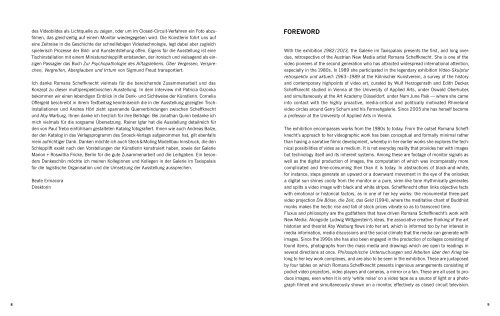ROMANA SCHEFFKNECHT 1982 2013 - romana scheffknecht videos
ROMANA SCHEFFKNECHT 1982 2013 - romana scheffknecht videos
ROMANA SCHEFFKNECHT 1982 2013 - romana scheffknecht videos
Sie wollen auch ein ePaper? Erhöhen Sie die Reichweite Ihrer Titel.
YUMPU macht aus Druck-PDFs automatisch weboptimierte ePaper, die Google liebt.
des Videobildes als Lichtquelle zu zeigen, oder um im Closed-Circuit-Verfahren ein Foto abzufilmen,<br />
das gleichzeitig auf einem Monitor wiedergegeben wird. Die Künstlerin führt uns auf<br />
eine Zeitreise in die Geschichte der schnelllebigen Videotechnologie, legt dabei aber zugleich<br />
spielerisch Prozesse der Bild- und Kunstentstehung offen. Eigens für die Ausstellung ist eine<br />
Tischinstallation mit einem Miniaturschlepplift entstanden, der ironisch und vielsagend als ein-<br />
zigen Passagier das Buch Zur Psychopathologie des Alltagslebens. Über Vergessen, Versprechen,<br />
Vergreifen, Aberglauben und Irrtum von Sigmund Freud transportiert.<br />
Ich danke Romana Scheffknecht vielmals für die bereichernde Zusammenarbeit und das<br />
Konzept zu dieser multiperspektivischen Ausstellung. In dem Interview mit Patricia Grzonka<br />
bekommen wir einen lebendigen Einblick in die Denk- und Sichtweise der Künstlerin. Cornelia<br />
Offergeld beschreibt in ihrem Textbeitrag kenntnisreich die in der Ausstellung gezeigten Tisch-<br />
installationen und Andrea Hörl zieht spannende Querverbindungen zwischen Scheffknecht<br />
und Aby Warburg. Ihnen danke ich herzlich für ihre Beiträge. Bei Jonathan Quinn bedanke ich<br />
mich vielmals für die sorgsame Übersetzung. Rainer Iglar hat die Ausstellung detailreich für<br />
den von Paul Trebo einfühlsam gestalteten Katalog fotografiert. Ihnen wie auch Andreas Balze,<br />
der den Katalog in das Verlagsprogramm des Snoeck-Verlags aufgenommen hat, gilt ebenfalls<br />
mein aufrichtiger Dank. Danken möchte ich auch Steck & Moling Modellbau Innsbruck, die den<br />
Schlepplift exakt nach den Vorstellungen der Künstlerin konstruiert haben, sowie der Galerie<br />
Marion + Roswitha Fricke, Berlin für die gute Zusammenarbeit und die Leihgaben. Ein besonders<br />
Dankeschön möchte ich meinen Kolleginnen und Kollegen in der Galerie im Taxispalais<br />
für die logistische Organisation und die Umsetzung der Ausstellung aussprechen.<br />
Beate Ermacora<br />
Direktorin<br />
FoReWoRD<br />
With the exhibition <strong>1982</strong> / <strong>2013</strong>, the Galerie im Taxispalais presents the first, and long over-<br />
due, retrospective of the Austrian New Media artist Romana Scheffknecht. She is one of the<br />
video pioneers of the second generation who has attracted widespread international attention,<br />
especially in the 1980s. In 1989 she participated in the legendary exhibition Video-Skulptur<br />
retrospektiv und aktuell: 1963–1989 at the Kölnischer Kunstverein, a survey of the history<br />
and contemporary highpoints of video art, curated by Wulf Herzogenrath and Edith Decker.<br />
Scheffknecht studied in Vienna at the University of Applied Arts, under Oswald Oberhuber,<br />
and simultaneously at the Art Academy Düsseldorf, under Nam June Paik — where she came<br />
into contact with the highly proactive, media-critical and politically motivated Rhineland<br />
video circles around Gerry Schum and his Fernsehgalerie. Since 2005 she has herself become<br />
a professor at the University of Applied Arts in Vienna.<br />
The exhibition encompasses works from the 1980s to today. From the outset Romana Scheff-<br />
knecht’s approach to her videographic work has been conceptual and formally minimal rather<br />
than having a narrative filmic development, whereby in her earlier works she explores the tech-<br />
nical possibilities of video as a medium. It is not everyday reality that provides her with images<br />
but technology itself and its inherent systems. Among these are footage of monitor signals as<br />
well as the digital production of images, the computation of which was incomparably more<br />
complicated and time-consuming then than it is today. In abstractions of black-and-white,<br />
for instance, steps generate an upward or a downward movement in the eye of the onlooker,<br />
a digital sun shines coolly from the monitor or a pure, siren-like tone rhythmically generates<br />
and splits a video image with black and white stripes. Scheffknecht often links objective facts<br />
with emotional or historical factors, as in one of her key works: the monumental three-part<br />
video projection Die Börse, die Zeit, das Geld (1994), where the meditative chant of Buddhist<br />
monks makes the hectic rise and fall of stock prices vibrate so as to transcend time.<br />
Fluxus and philosophy are the godfathers that have driven Romana Scheffknecht’s work with<br />
New Media. Alongside Ludwig Wittgenstein’s ideas, the associative creative thinking of the art<br />
historian and theorist Aby Warburg flows into her art, which is informed too by her interest in<br />
media information, media discussions and the social climate that the media can generate with<br />
images. Since the 1990s she has also been engaged in the production of collages consisting of<br />
found items, photographs from the mass media and drawings which are open to readings in<br />
several directions at once. Philosophische Untersuchungen and Arbeiten über den Krieg belong<br />
to her key work complexes, and are also to be seen in the exhibition. These are juxtaposed<br />
by four tables on which Romana Scheffknecht presents ingenious arrangements consisting of<br />
pocket video projectors, video players and cameras, a mirror or a fan. These are all used to pro-<br />
duce images, even when it is only ‘white noise’ on a video tape as a source of light or a photo-<br />
graph filmed and simultaneously shown on a monitor, effectively as closed circuit television.<br />
8 9


